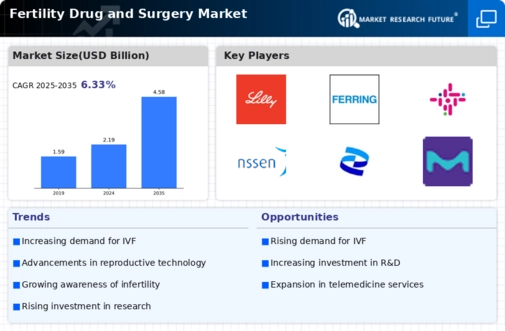Market Analysis
In-depth Analysis of Fertility Drug Surgery Market Industry Landscape
The fertility drug and surgery market plays a critical role in addressing reproductive health challenges, offering solutions for individuals and couples seeking assistance in conception. The market dynamics in this sector are influenced by a combination of factors, including advancements in medical technology, changing demographics, and regulatory considerations. The increasing prevalence of infertility worldwide greatly affects the equilibrium in market forces. Factors like lifestyle modification, late parenting etc. along with the environmental influences are showing a growing trend in fertility drugs and surgical procedures for reproductive health concerns. The assisted reproductive technologies dynamically shift market conditions through continuous improvements. The development of fertility drugs and surgical methods such as IVF, ICSI among others propels the market because they help solve problems related to infertility. It is thus the delay in parenthood especially among developed nations that has added to these age-related reproduction challenges. With more people and couples seeking help in solving age-related fertility problems, the demand for fertility drugs as well as surgical interventions increases thereby influencing market dynamics. Regulatory standards for fertility drugs and surgical intervention influence market dynamics. Manufacturers are stringently approved to ensure safety and efficacy of their products, consequentially shaping the competitive landscape and altering market entry. Globalization of the fertility market affects market dynamics. With reproductive healthcare services becoming increasingly available in the world, there is an expansion of fertility drugs and surgical interventions as well which becomes a catalyst for market growth and diversification. Innovation in drug delivery systems for fertility drugs affects market dynamics. Infertility drugs became widely adopted due to innovations such as subcutaneous injections and extended release formulations that facilitate patient convenience by making it easier for patients to adhere. The identification of male infertility as an important determinant in reproductive health adds to the market dynamics. Fertility drugs and surgical interventions meant as a male fertility issues solution, become part of the overall market in terms that infertility treatment becomes more holistic. The growing trend of personalized medicine impacts the market dynamics in fertility sector. Precisely targeting fertility treatments to specific patient profiles, such as genetic conditions and particular reproductive health problems is addressed by manufacturers and healthcare givers. Psychosocial factors and such increased awareness with less stigma attached to infertility also have its implications on market dynamics. An increasingly open discussion about fertility issues leads people and couples to get medically influenced, pushing the market on an upward trend.
The fertility drug and surgery market feature a competitive landscape with pharmaceutical companies and medical device manufacturers vying for market share. Intense competition drives ongoing research, product development, and marketing efforts, providing consumers with a diverse range of treatment options.









Leave a Comment